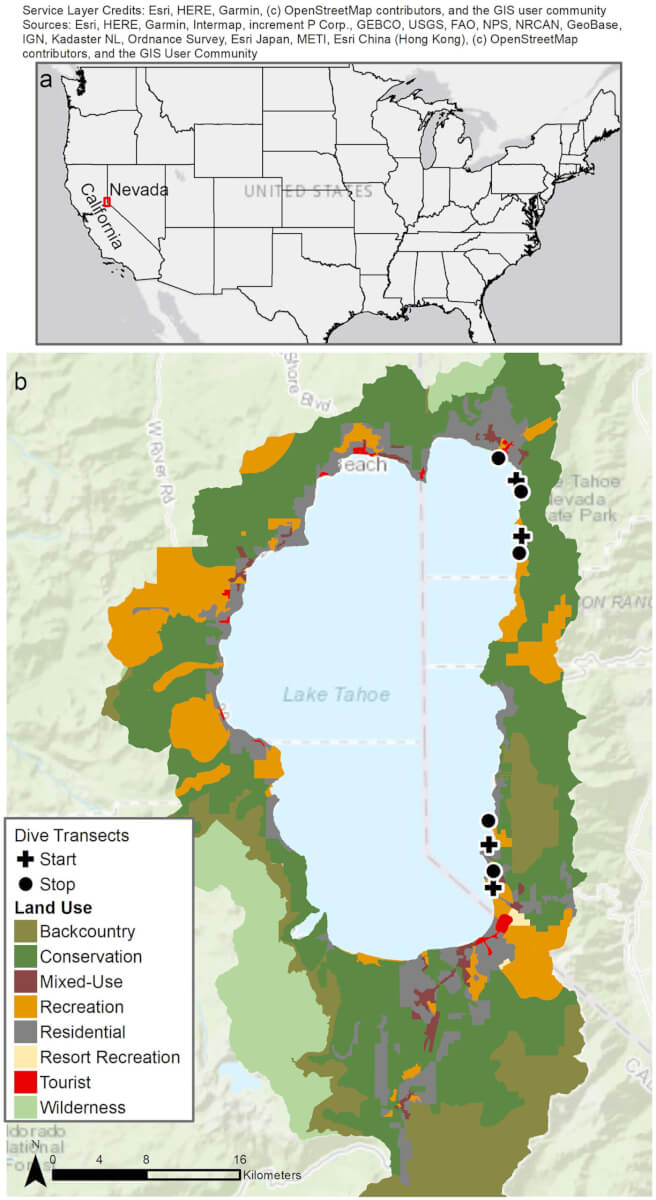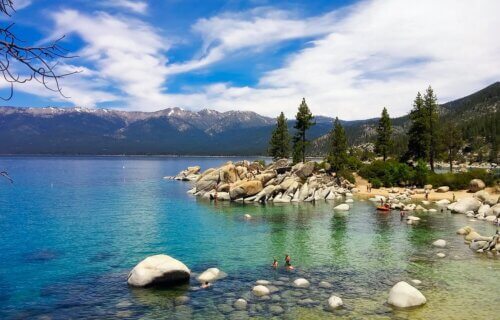RENO, Nev. — It’s no secret that plastic litter polluting the forests, oceans, and parks is a major ecological hurdle facing mankind’s future on Earth. Now, researchers from the Desert Research Institute (DRI) are pointing to Lake Tahoe as a microcosm of what’s occurring across countless bodies of water and green areas all over the world. After conducting one of the first studies ever to utilize trash-collecting scuba divers in the freshwater lake that straddles the California and Nevada border, scientists tallied 673 plastic items within just one small fraction of the lake.
In collaboration with the UC Davis Tahoe Environmental Research Center, researchers from DRI conducted this study with the nonprofit Clean Up the Lake. The team’s main aim was to get a better idea of the true level of pollution in the iconic lake. Lake Tahoe is the largest alpine lake in all of North America and annually attracts millions of visitors looking to enjoy its beaches, featuring crystal-clear water and ski resorts.
To start, study authors separated litter into categories based on use (food containers, water bottles, etc.), as well as the actual chemical composition of the plastic. Insights gained from this approach allowed the research team to form a better understanding of the source of large pieces of litter in the lake. This strategy also helped scientists determine if larger pieces of plastic are major sources of microplastics as they gradually break down and degrade over time. Prior studies show that Lake Tahoe’s waters do indeed carry lots of microplastics, defined as any plastic smaller than a pencil eraser.
“There’s very little work on submerged plastic litter in lakes,” says Monica Arienzo, Ph.D., associate research professor of hydrology at DRI and one of the study’s lead authors, in a media release. “And I think that’s a real issue, because when we think about how plastics may be moving in freshwater systems, there’s a good chance that they’ll end up in a lake.”

In order to collect and remove the litter, a group of divers swam along the lakebed near Lake Tahoe Nevada State Park and Zephyr Cove; a distance of about 5.7 miles. Along the way they discovered 83 pieces of plastic litter per kilometer. Notably, the lakebed near Hidden Beach and South Sand Harbor had significantly more trash (140 items/km and 124 items/km, respectively). Not a single stretch of the lakebed was totally free of plastic litter.
Looking at specific types of plastic, the most common varieties included food containers, bottles, plastic bags, and toys, as well as various other items deemed un-categorizable.
“There’s a lot of education we can do, as well as continuing to work on reducing the use of those plastics,” Prof. Arienzo adds. “Because we have to start thinking about turning that plastic pipe off.”
Next, working with study co-author Julia Davidson, then an undergraduate student working in Arienzo’s lab, Prof. Arienzo detected and identified the different types of plastic making up 516 of the litter samples. From there, an instrument featuring infrared light fingerprinted and identified the material.
This led to the revelation that the six most common plastics were polyvinyl chloride (PVC), polystyrene, polyester/polyethylene terephthalate, polyethylene, polypropylene, and polyamide. This vital data will contribute to Prof. Arienzo’s ongoing microplastics research in the local region and help to identify specific sources of small plastic fragments.
“When we study microplastics, we only have the chemical information, or the plastic type,” Davidson comments. “We don’t know where it came from—a plastic bag, toy, or otherwise— because it’s just a tiny piece of plastic. But now we can use this litter data to point to the dominant types of plastics and compare them to microplastic data.”
In conclusion, researchers believe this study can help inform efforts by Tahoe-area communities to address plastic litter. For instance, South Lake Tahoe’s 2022 ban on single-use plastic bottles and Truckee’s ban on single-use food containers. These findings also highlight how scientists can work with nonprofits to collect data capable of helping to address local environmental concerns.
“I think one of the things that’s really cool about this project is the collaboration between DRI, Clean Up the Lake, and UC Davis at Tahoe,” Prof. Arienzo concludes. “It demonstrates the power of bringing together a nonprofit that really wants to clean up Tahoe, while collecting data in the process that can help answer scientific questions.”
The study is published in the journal Applied Spectroscopy.
